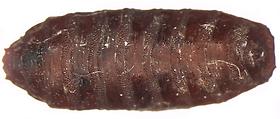Blow fly puparium
Larvae of different species move different distances from the body prior to pupariation, some as much as 8 meters. The larvae becomes shorter and stouter and the outer cuticle (skin layer) of the larvae hardens into the puparium and slowly darkens over a period of about 10 hours. Adults will emerge between 77 and 134 hours after pupariation depending on the temperature.
Cleveland Museum of Natural History
Image 3 of 7
Life cycle of the black blow fly
Adult female blow flies arrive within minutes to lay eggs on a cadaver. Each deposits about 250 eggs in the natural openings of the body and open wounds. The eggs hatch into first-stage maggots within 24 hours. These feed and then molt into second-stage maggots, which feed for several hours, and then molt into third-stage maggots. Masses of third-stage maggots may produce heat, which can raise the temperature around them more than 10° C. After more feeding, the third-stage maggots move away from the body and metamorphize into adult flies.
